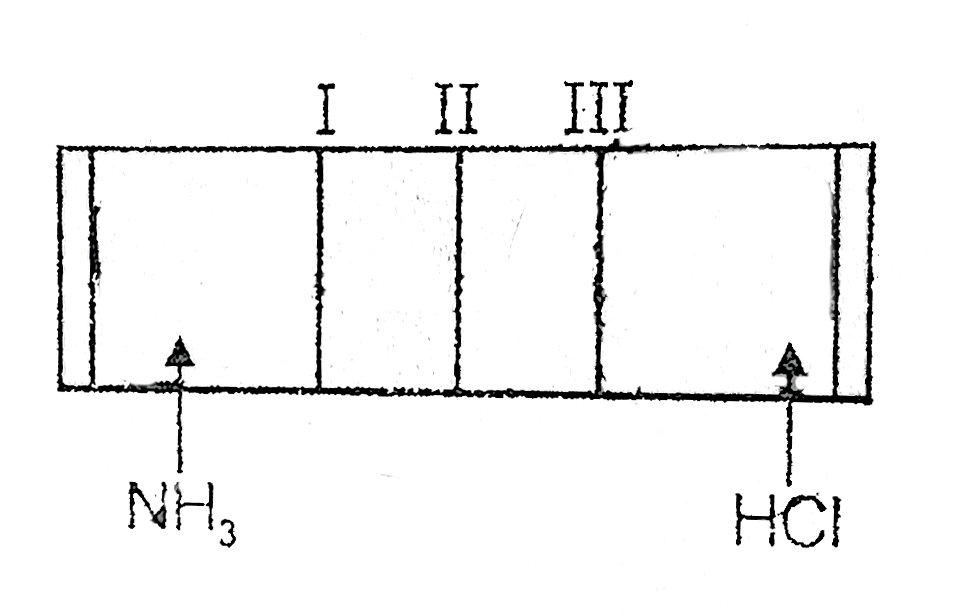In the following diagram,container of NH3 gas and container of HCl gas, connected through a long tube, are opened simultaneously at both ends, the white NH4Cl ring first formed will be at Q point. If OP=40cm, then find OQ -

35 cm
23.74 cm
30 cm
31.25 cm
The correct Answer is:B
Let OQ =x cm so QP = ( 40 - x ) cm
Diffused volume of NH3 gas =Area of T.S. of tube × Distance travelled by NH3 gas
VNH3=A×OQ=Ax
{Where A is area of T.S. of tube }
Similarly in the same time,
Diffused volume of HCl gas = Area of T.S. of tube × Distance travelled by HCl gas
VHCl=A×QP=A(40−x)
From Graham's Law of diffusion
⇒rNH3rHCl=√MHClMNH3
⇒VNH3/tVHCl/t=√36.517=1.46
⇒x(40−x)=1.46⇒x=23.74cm
∴OQ=23.74cm
Topper's Solved these Questions
- GASEOUS STATE Book:MOTIONChapter:GASEOUS STATE Exercise:EXERCISE -1 (INTRODUCTION & STATE PARAMETERS)
Explore 44 Videos
- GASEOUS STATE Book:MOTIONChapter:GASEOUS STATE Exercise:EXERCISE-2(LEVEL-I)
Explore 48 Videos
- GASEOUS STATE Book:MOTIONChapter:GASEOUS STATE Exercise:SOLVED EXAMPLE
Explore 15 Videos
- ELECTROCHEMISTRYBook:MOTIONChapter:ELECTROCHEMISTRYExercise:EXERCISE-4,II
Explore 44 Videos
- GOCBook:MOTIONChapter:GOCExercise:Exercise - 4 Level - II
Explore 14 Videos
Similar Questions
At room temperature, NH3 gas at 1 atm and HCl gas at P atm are allowed to effuse through identical pinholes from oppoite ends of a glass tube of 1 metre length and uniform cross section. NH4Cl is first fomed at a distance of 60 cm from the end through whieh, HCI gas is sent in. What is the value of P?
View SolutionThe reaction between gaseous NH3 and HBr produces a white solide NH4Br. Suppose a small quantity of gaseous NH3 and gaseous HBr are introduced simultaneously into opposite ends of an open tube which is one metre long. Calculate the distance of white solid formed from the end which was used to introduce NH3
View Solution
Knowledge Check
A bottle of dry NH3 and another bottle of dry HCl connected through a long tube are opened simultaneously at both ends of the tube. The white ring (NH4Cl) first formed will be
AAt the centre of the tubeBNear the HCl bottleCNear the ammonia bottleDThroughout the length of the tubeA bottle of dry ammonia and a bottle of dry hydrogen chloride connected through a long tube are opened simultaneously at both ends. The white ammonium chloride ring first formed will be
Aat the centre of the tube.Bnear the hydrogen chloride b0ttle.Cnear the ammonia bottle.Dthroughout the length of the tubeA bottle of dry ammonia and a bottle of dry hydrogen chloride connected through a long tube are opened simultaneously at both ends. The white ammonium chloride ring first formed will be
Aat the centre of the tubeBnear the hydrogen chloride bottleCnear the ammonia bottleDthroughout the length of the tube.
A bottle contaning ammonia and a bottle containing hydrogen chloride are connected through along tube are opened simultaneously at both ends. The white ammonium chloride first formed will be :
View SolutionA bottle of dry ammonia and a bottle of dry hydrogen chloride connected through a long tube are opened simultaneously at both ends. The white ammonium chloride ring first formed will be
View SolutionA bottle of dry ammonia and one of dry hydrogen chloride are connected through a long tube. The stoppers at both ends of the tube are opened simultaneously. The white ammonium chloride ring first formed will be
View SolutionThe constant motion and high velocities of gas particles lead to some important practical consquences. One such consquences is that gases mix rapidly when they come in contact. Take the stopper off a bottle of perfume, for instance, and the odour will spread rapidly through the room as perfume molecules mix with the molecules in the air. This mixing of different gases by random molecular motion and with frequent collision is called diffusion. A similar process in which gas molecules escape without collision through a tiny hole into a vacuum is called effusion. Both the processes follow Graham's law which is mathematically put as r∝√1/d. The average distance travelled by molecules between successive collisions is called mean free path.
Answer the following questions on the basis of the above information:
The stop cocks of the bulbs X (containing NH3) and Y (containing HCl), both under indentical conditions, are opened simultaneously. White fumes of NH4Cl, are formed at point B. If AB=36.5cm, then BC is approximately

View SolutionTwo pieces of cotton wool soaked separetely in aqueous solution of NH3 and HCl are placed at opposite ends of a close glass tube as shown in diagram

Select nearest position where white solid is formed
View Solution

